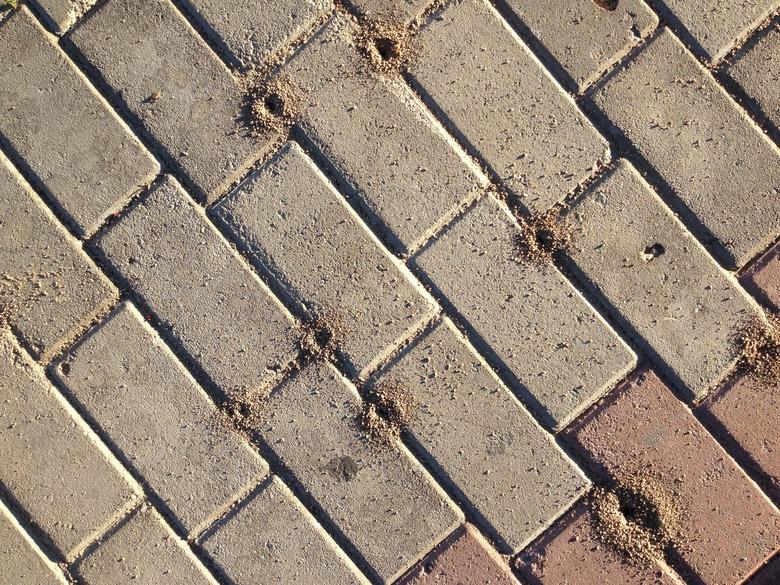How To Get Rid Of Ants Under Paving
The ants under the patio paving are among about 10,000 ant species in the family Formicidae. Ants are found nearly everywhere, including in the walls of your house, under hardscape, and in the garden. Only a few remote locations and islands, including Antarctica, Iceland, and Greenland, lack a native ant species. Getting rid of ants may be a temporary solution, but if you can eliminate them for a few seasons or a year or three, it's worth the effort to destroy the nest.
Finding Ants Under a Patio
When you find ants invading your kitchen and small ants in the bathroom, they're creeping into your home from a hidden nest. Ants generally have large nests with thousands of workers foraging for food to feed the queens, adults, young ants, and larvae. Often, the actual nest is hidden inside the walls or outside next to the foundation or under the paving of your driveway, walks, or patio. The worker ants enter your home looking for food and/or water.
When you trace the ants back to the patio, you may see a trail emerging from dirt and cracks in the paving, traveling to and from your home. While there is a specific ant species, the European pavement ant (Tetramorium immigrans), that is associated with nesting in the soil around and under paving, many other native and introduced ant species thrive in and around your home. No matter the species, it's important to determine what is attracting the ants and the best way to eliminate the scurrying scavengers.
Discourage Foraging Ants
Reduce the number of ants foraging in and around your home by eliminating water and food sources. Ants seek out sugary, greasy, and/or protein-rich foods, which can vary during the year depending on the ant species. To discourage ants, clean up spills and wipe counters with soapy water, household cleaners, or vinegar to disrupt the scent trails. Also store food in airtight containers and keep your floors, trash cans, pet dishes, and cupboards clean.
One eco-friendly method of eliminating ants and other pests is to sprinkle food-grade diatomaceous earth along ant trails. Put on gloves and a respirator before applying the diatomaceous earth. Ants scurry through the silica-filled powder, and the sharp edges of the silica particles slice through their exoskeletons and dehydrate them.
Also check around the perimeter of your home. Rake mulch and plant debris away from the foundation to disrupt and discourage ant trails. Caulk the cracks and crevices that the ants are using as entry points. Repair any dripping faucets, pipes, sprinkler heads, and other water sources.
Get Rid of Ants Under Paving
To eliminate ants living under paving stones and other hardscape, consider using ant baits in the house and near the ant trails leading to and from the nest. While there are a multitude of insecticides available for both indoor and outdoor use, the active ingredients are not safe for humans and pets, especially cats. In addition, applying fast-acting insecticidal products may only encourage the ants to move their nest. Ant sprays and dusts only kill the workers that come in contact with the insecticide; they are not very effective against the remaining ants in the nest.
Ant baits work slowly, but they are more effective and safer when dealing with aggressive species, like fire ants (Solenopsis spp.). The foraging workers carry the bait back to the nest, where the larvae feed on the treated food and produce the liquid that the other ants eat. Ant baits can be placed on windowsills, inside cabinets, and wherever the ants are entering your home. They can also be placed along ant trails outside and tucked into voids under the paving, but be sure that children and pets cannot access the baits.
While commercially prepared ant and fire ant baits are available, you can also make your own baits for the less aggressive ant species using cornmeal, soybean oil, and boric acid, or borax. Put on your gloves, safety goggles, and mask. Then:
- Measure out 1 part boric acid or borax and 9 parts cornmeal.
- Mix with 1 to 2 tablespoons soybean oil to make a paste.
- Put the mixture in small containers, such as bottle caps or jar lids.
- Place them along the ant trails.
Another ant bait recipe incorporates boric acid and sugar. Combine 1/3 cup boric acid and 1 cup granulated sugar or powdered sugar. Use the mixture as a dry powder along the ant trails or add 1/4 cup warm water to make a thick paste and fill jar lids or bottle caps to place where the ants gather. Do not use other insecticides when using baits, as the workers carry the bait back to the nest to poison the larvae, queens, and other ants.
